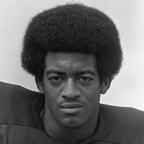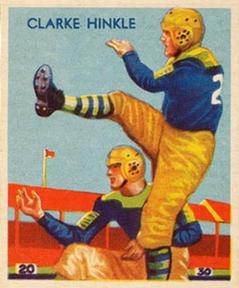
David Steven Brown was an American professional football player who was a cornerback for 15 seasons in the National Football League (NFL) for the Pittsburgh Steelers (1975), Seattle Seahawks (1976–1986), and Green Bay Packers (1987–1989). He was selected as a second-team All-NFL player in 1984 and a second-team All-AFC player in 1985. His 62 career interceptions ranks tied for tenth in NFL history, with only five players having more interceptions in a career since his career ended in 1989. His 50 interceptions with the Seahawks remains a club record.

William Clarke Hinkle was an American professional football fullback and linebacker for the Green Bay Packers of the National Football League (NFL), also playing occasionally as a placekicker and punter. He was elected to the Pro Football Hall of Fame as part of its second class of inductees in 1964.

John Victor McNally, nicknamed "Johnny Blood", was an American professional football player and coach. McNally was named a member of the NFL 1930s All-Decade Team and was inducted into the Pro Football Hall of Fame as a player in 1963, as one of the Hall of Fame's 17 charter members. McNally played for six different teams between 1925 and 1941, with his longest tenure being with the Green Bay Packers, first from 1929 to 1933 and then from 1935 to 1936. McNally served in the United States Army Air Corps during World War II. Following the war he attempted to return to football in 1945, but an injury ended his playing career.
The 1941 NFL season was the 22nd regular season of the National Football League. Before the season, Elmer Layden was named the first Commissioner of the NFL, while Carl Storck resigned as league president. Layden also took on the duties of president and signed a five-year contract at $20,000 annually.

The 1943 NFL season marked the 24th year of the National Football League. A total of 38 regular season games were scheduled, starting on Sunday, September 19 and culminating on Sunday, December 12.

Emlen Lewis Tunnell, nicknamed "the Gremlin", was an American professional football player and coach. He was the first African-American to play for the New York Giants and also the first to be inducted into the Pro Football Hall of Fame.

August Michael Michalske, sometimes known as "Iron Mike", was an American football player and coach. He was inducted into the Pro Football Hall of Fame as part of its second induction class in 1964. He was also named in 1969 to the NFL 1920s All-Decade Team.

Eugene A. Ronzani was a professional football player and coach in the National Football League (NFL). He was the second head coach of the Green Bay Packers, from 1950 to 1953, and resigned with two games remaining in the 1953 season.
Philip Jacob Handler was an American football player and coach who spent his entire professional career in the city of Chicago. He had a seven-year, 53-game NFL playing career, during which he was named All-Pro four times. On three separate occasions, Handler served as head coach of the Chicago Cardinals, and later as an assistant coach for the Chicago Bears. He served as an assistant coach for the Cardinals when they won the 1947 NFL Championship; and with the Bears when they won the 1963 NFL Championship.
Card-Pitt was the team created by the temporary merger of two National Football League (NFL) teams, the Chicago Cardinals and the Pittsburgh Steelers, during the 1944 season. It was the second such merger for the Steelers, who had combined with the Philadelphia Eagles in 1943 to form the "Steagles". The arrangement was made necessary by the loss of numerous players to World War II military service, and was dissolved upon completion of the season. The war ended before the start of the 1945 season, and both teams resumed normal operations.

Joseph Anthony Bach was one of Notre Dame's famed "Seven Mules" and later the head coach for the NFL's Pittsburgh Pirates (1935–36) and later the renamed Pittsburgh Steelers (1952–53).
The 1957 Detroit Lions season was the franchise's 28th season in the National Football League (NFL) and their 24th as the Detroit Lions. Under first-year head coach George Wilson, the Lions won their fourth and most recent NFL title.
Joseph Daniell Hoague was a professional American football player in the National Football League (NFL) with the Pittsburgh Steelers, and later the Philadelphia-Pittsburgh Steagles, and the Boston Yanks. Prior to joining the NFL, Hoague played college football at Colgate University.
John M. Hinkle was an American football player and coach. He played professionally in the National Football League (NFL) with the New York Giants, Philadelphia Eagles and the "Steagles". Hinkle later became a football coach, and was head coach at Drexel.
Harold Hinte was an American professional football player who was an end in the National Football League (NFL) for the Green Bay Packers and Pittsburgh Steelers during the 1942 NFL season. He played college football for the Pittsburgh Panthers. After his brief football career, he served in the United States Army during World War II and was a high school basketball and football coach.
Louis Thomas Midler was an American football guard and tackle who played two seasons in the National Football League (NFL) for the Pittsburgh Pirates and Green Bay Packers. He played college football for the Minnesota Golden Gophers and was selected by the Pirates in the fifth round of the 1938 NFL draft.
Frank William Steen was an American football end. He played college football for the Rice Owls. Although not selected in the National Football League Draft, he signed with the Green Bay Packers for the 1939 season and played three games as they won the NFL championship.
The Pennsylvania Polka refers to a series of moves affecting the Philadelphia Eagles and Pittsburgh Steelers franchises in the National Football League (NFL) from 1940 to 1941.
Joseph A. Zombek was an American football defensive end and punter who played two seasons in the National Football League (NFL) for the Pittsburgh Steelers. He played college football at Pittsburgh, and was drafted by the Steelers in the 9th round of the 1954 NFL draft.








